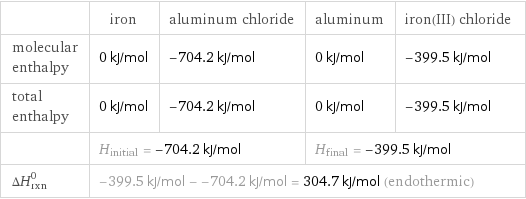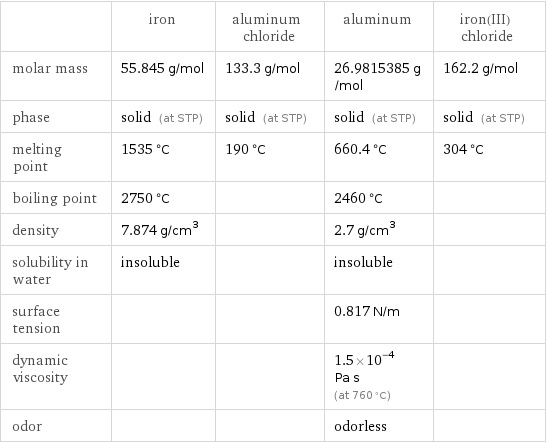Input interpretation

Fe (iron) + AlCl_3 (aluminum chloride) ⟶ Al (aluminum) + FeCl_3 (iron(III) chloride)
Balanced equation

Balance the chemical equation algebraically: Fe + AlCl_3 ⟶ Al + FeCl_3 Add stoichiometric coefficients, c_i, to the reactants and products: c_1 Fe + c_2 AlCl_3 ⟶ c_3 Al + c_4 FeCl_3 Set the number of atoms in the reactants equal to the number of atoms in the products for Fe, Al and Cl: Fe: | c_1 = c_4 Al: | c_2 = c_3 Cl: | 3 c_2 = 3 c_4 Since the coefficients are relative quantities and underdetermined, choose a coefficient to set arbitrarily. To keep the coefficients small, the arbitrary value is ordinarily one. For instance, set c_1 = 1 and solve the system of equations for the remaining coefficients: c_1 = 1 c_2 = 1 c_3 = 1 c_4 = 1 Substitute the coefficients into the chemical reaction to obtain the balanced equation: Answer: | | Fe + AlCl_3 ⟶ Al + FeCl_3
Structures

+ ⟶ +
Names

iron + aluminum chloride ⟶ aluminum + iron(III) chloride
Reaction thermodynamics
Enthalpy

| iron | aluminum chloride | aluminum | iron(III) chloride molecular enthalpy | 0 kJ/mol | -704.2 kJ/mol | 0 kJ/mol | -399.5 kJ/mol total enthalpy | 0 kJ/mol | -704.2 kJ/mol | 0 kJ/mol | -399.5 kJ/mol | H_initial = -704.2 kJ/mol | | H_final = -399.5 kJ/mol | ΔH_rxn^0 | -399.5 kJ/mol - -704.2 kJ/mol = 304.7 kJ/mol (endothermic) | | |
Equilibrium constant
![Construct the equilibrium constant, K, expression for: Fe + AlCl_3 ⟶ Al + FeCl_3 Plan: • Balance the chemical equation. • Determine the stoichiometric numbers. • Assemble the activity expression for each chemical species. • Use the activity expressions to build the equilibrium constant expression. Write the balanced chemical equation: Fe + AlCl_3 ⟶ Al + FeCl_3 Assign stoichiometric numbers, ν_i, using the stoichiometric coefficients, c_i, from the balanced chemical equation in the following manner: ν_i = -c_i for reactants and ν_i = c_i for products: chemical species | c_i | ν_i Fe | 1 | -1 AlCl_3 | 1 | -1 Al | 1 | 1 FeCl_3 | 1 | 1 Assemble the activity expressions accounting for the state of matter and ν_i: chemical species | c_i | ν_i | activity expression Fe | 1 | -1 | ([Fe])^(-1) AlCl_3 | 1 | -1 | ([AlCl3])^(-1) Al | 1 | 1 | [Al] FeCl_3 | 1 | 1 | [FeCl3] The equilibrium constant symbol in the concentration basis is: K_c Mulitply the activity expressions to arrive at the K_c expression: Answer: | | K_c = ([Fe])^(-1) ([AlCl3])^(-1) [Al] [FeCl3] = ([Al] [FeCl3])/([Fe] [AlCl3])](../image_source/dd5d555fb48dc3ec5f2b093d6de873e8.png)
Construct the equilibrium constant, K, expression for: Fe + AlCl_3 ⟶ Al + FeCl_3 Plan: • Balance the chemical equation. • Determine the stoichiometric numbers. • Assemble the activity expression for each chemical species. • Use the activity expressions to build the equilibrium constant expression. Write the balanced chemical equation: Fe + AlCl_3 ⟶ Al + FeCl_3 Assign stoichiometric numbers, ν_i, using the stoichiometric coefficients, c_i, from the balanced chemical equation in the following manner: ν_i = -c_i for reactants and ν_i = c_i for products: chemical species | c_i | ν_i Fe | 1 | -1 AlCl_3 | 1 | -1 Al | 1 | 1 FeCl_3 | 1 | 1 Assemble the activity expressions accounting for the state of matter and ν_i: chemical species | c_i | ν_i | activity expression Fe | 1 | -1 | ([Fe])^(-1) AlCl_3 | 1 | -1 | ([AlCl3])^(-1) Al | 1 | 1 | [Al] FeCl_3 | 1 | 1 | [FeCl3] The equilibrium constant symbol in the concentration basis is: K_c Mulitply the activity expressions to arrive at the K_c expression: Answer: | | K_c = ([Fe])^(-1) ([AlCl3])^(-1) [Al] [FeCl3] = ([Al] [FeCl3])/([Fe] [AlCl3])
Rate of reaction
![Construct the rate of reaction expression for: Fe + AlCl_3 ⟶ Al + FeCl_3 Plan: • Balance the chemical equation. • Determine the stoichiometric numbers. • Assemble the rate term for each chemical species. • Write the rate of reaction expression. Write the balanced chemical equation: Fe + AlCl_3 ⟶ Al + FeCl_3 Assign stoichiometric numbers, ν_i, using the stoichiometric coefficients, c_i, from the balanced chemical equation in the following manner: ν_i = -c_i for reactants and ν_i = c_i for products: chemical species | c_i | ν_i Fe | 1 | -1 AlCl_3 | 1 | -1 Al | 1 | 1 FeCl_3 | 1 | 1 The rate term for each chemical species, B_i, is 1/ν_i(Δ[B_i])/(Δt) where [B_i] is the amount concentration and t is time: chemical species | c_i | ν_i | rate term Fe | 1 | -1 | -(Δ[Fe])/(Δt) AlCl_3 | 1 | -1 | -(Δ[AlCl3])/(Δt) Al | 1 | 1 | (Δ[Al])/(Δt) FeCl_3 | 1 | 1 | (Δ[FeCl3])/(Δt) (for infinitesimal rate of change, replace Δ with d) Set the rate terms equal to each other to arrive at the rate expression: Answer: | | rate = -(Δ[Fe])/(Δt) = -(Δ[AlCl3])/(Δt) = (Δ[Al])/(Δt) = (Δ[FeCl3])/(Δt) (assuming constant volume and no accumulation of intermediates or side products)](../image_source/833d05198734321923b74cb4dc171d6e.png)
Construct the rate of reaction expression for: Fe + AlCl_3 ⟶ Al + FeCl_3 Plan: • Balance the chemical equation. • Determine the stoichiometric numbers. • Assemble the rate term for each chemical species. • Write the rate of reaction expression. Write the balanced chemical equation: Fe + AlCl_3 ⟶ Al + FeCl_3 Assign stoichiometric numbers, ν_i, using the stoichiometric coefficients, c_i, from the balanced chemical equation in the following manner: ν_i = -c_i for reactants and ν_i = c_i for products: chemical species | c_i | ν_i Fe | 1 | -1 AlCl_3 | 1 | -1 Al | 1 | 1 FeCl_3 | 1 | 1 The rate term for each chemical species, B_i, is 1/ν_i(Δ[B_i])/(Δt) where [B_i] is the amount concentration and t is time: chemical species | c_i | ν_i | rate term Fe | 1 | -1 | -(Δ[Fe])/(Δt) AlCl_3 | 1 | -1 | -(Δ[AlCl3])/(Δt) Al | 1 | 1 | (Δ[Al])/(Δt) FeCl_3 | 1 | 1 | (Δ[FeCl3])/(Δt) (for infinitesimal rate of change, replace Δ with d) Set the rate terms equal to each other to arrive at the rate expression: Answer: | | rate = -(Δ[Fe])/(Δt) = -(Δ[AlCl3])/(Δt) = (Δ[Al])/(Δt) = (Δ[FeCl3])/(Δt) (assuming constant volume and no accumulation of intermediates or side products)
Chemical names and formulas

| iron | aluminum chloride | aluminum | iron(III) chloride formula | Fe | AlCl_3 | Al | FeCl_3 Hill formula | Fe | AlCl_3 | Al | Cl_3Fe name | iron | aluminum chloride | aluminum | iron(III) chloride IUPAC name | iron | trichloroalumane | aluminum | trichloroiron
Substance properties

| iron | aluminum chloride | aluminum | iron(III) chloride molar mass | 55.845 g/mol | 133.3 g/mol | 26.9815385 g/mol | 162.2 g/mol phase | solid (at STP) | solid (at STP) | solid (at STP) | solid (at STP) melting point | 1535 °C | 190 °C | 660.4 °C | 304 °C boiling point | 2750 °C | | 2460 °C | density | 7.874 g/cm^3 | | 2.7 g/cm^3 | solubility in water | insoluble | | insoluble | surface tension | | | 0.817 N/m | dynamic viscosity | | | 1.5×10^-4 Pa s (at 760 °C) | odor | | | odorless |
Units
